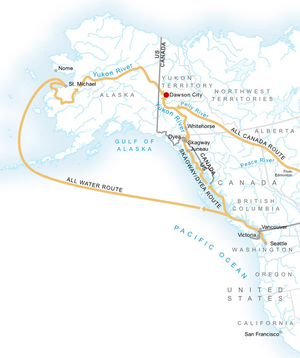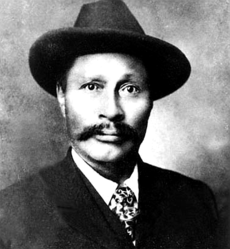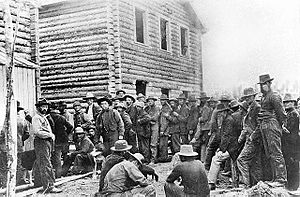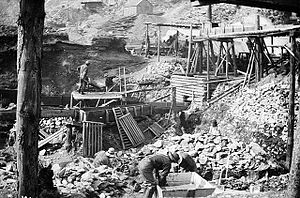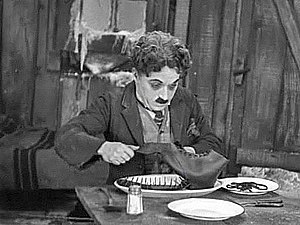Difference between revisions of "AY Honors/Gold Prospecting/Answer Key"
m (1 revision from w:Klondike Gold Rush: transwiki merge of w:Klondike Gold Rush to AY Honor Gold Prospecting) |
m (moved Transwiki:Klondike Gold Rush to AY Honor Gold Prospecting: transwiki merge of w:Klondike Gold Rush to AY Honor Gold Prospecting) |
(No difference)
| |
Revision as of 01:27, 30 July 2009
The Klondike Gold Rush, sometimes referred to as the Yukon Gold Rush or Alaska Gold Rush, was a frenzy of gold rush immigration to and for gold prospecting, along the Klondike River near Dawson City, Yukon, Canada after gold was discovered there in the late 19th century. In total, about 12.5 million ounces of gold (about 20.12m3) have been taken from the Klondike area in the century since its discovery.&
Discovery
In August 1896, three people led by Keish (Skookum Jim Mason), a member of the Tagish First Nations, headed north, down the Yukon River from the Carcross area, looking for his sister Kate and her husband George Carmack. The party included Skookum Jim, his cousin, known as Dawson Charlie (or sometimes Tagish Charlie), and his nephew Patsy Henderson. After meeting up with George and Kate, who were fishing for salmon at the mouth of the Klondike River, they ran into Nova Scotian Robert Henderson who had been mining gold on the Indian River, just south of the Klondike. Henderson told George Carmack about where he was mining and that he did not want any "Siwashes" (meaning Indians) near him. On August 16, 1896,&& the Skookum party discovered rich placer gold deposits in Bonanza (Rabbit) Creek, Yukon. It is not clear who made the actual discovery, with some accounts saying that it was Kate Carmack, while others credit Skookum Jim. George Carmack was officially credited for the gold discovery because the actual claim was staked in his name. The group agreed to this because they felt that other miners would be reluctant to recognize a claim made by an Indian, given the strong racist attitudes of the time.&
The Rush Begins
The news spread to other mining camps in the Yukon River valley. Gold was first discovered in Rabbit Creek, which was later named Bonanza Creek because so many people came to the creek for gold. The Bonanza, Eldorado, and Hunker Creeks were rapidly staked by miners who had been previously working creeks and sandbars on the Fortymile and Stewart Rivers.
News reached the United States in July 1897 at the height of a significant series of financial recessions and bank failures in the 1890s. The American economy had been hard hit by the Panic of 1893 and the Panic of 1896 which caused widespread unemployment. Many who were adversely impacted by the financial crises were motivated to try their luck in the gold fields. The first successful prospectors arrived in San Francisco, California on July 15 and in Seattle, Washington on July 17, setting off the Klondike stampede. In 1898, the population in the Klondike may have reached 40,000, which threatened to cause a famine.
Men from all walks of life headed for the Yukon from as far away as New York, the United Kingdom, and Australia. Surprisingly, a large proportion were professionals, such as teachers and doctors, even a mayor or two, who gave up respectable careers to make the journey. Most were perfectly aware of their chance of finding significant amounts of gold were slim to none, and went for the adventure. As many as half of those who reached Dawson City kept right on going without doing any prospecting at all. Thus, by bringing large numbers of entrepreneurial adventurers to the region, the Gold Rush significantly contributed to the economic development of Western Canada, Alaska and the Pacific Northwest.
Most prospectors landed at the Alaskan towns of Skagway, or Dyea, both located at the head of the Lynn Canal. From these towns they traveled the Chilkoot Trail and crossed the Chilkoot Pass, or they hiked up to the White Pass into and proceeded thence to Lake Lindeman or Bennett Lake, the headwaters of the Yukon River. Here, some Template:Convert grueling miles from where they landed, prospectors built rafts and boats that would take them the final 500-plus miles (800-plus km) down the Yukon to Dawson City, near the gold fields. Stampeders had to carry a year's supply of goods — about a ton, more than half of it food — over the passes to be allowed to enter Canada. At the top of the passes, the stampeders encountered Canada's North West Mounted Police (NWMP and now the Royal Canadian Mounted Police) post that enforced that regulation, as well as customs and duties. It was put in place to avert shortages like those that had occurred in the previous two winters in Dawson City, and also to restrict the entry of guns, particularly handguns, into British territory. Another reason was to keep out of Canadian territory the criminal element which had established itself in Skagway and the other Yukon Ports (then still claimed as British territory), as well as the fears by British and Canadian authorities about a possible armed takeover of the goldfields as an American territory.&
Once the bulk of the prospectors arrived at Dawson City, most of the major mining claims of the region were already established. However, any major potential unrest with the idle population was averted with the firm authority of the NWMP under the command of Sam Steele. People would eat beans and bread, but rarely a lucky prospector could get his hands on some fresh meat.
Cultural legacy
Amongst the many to take part in the gold rush was writer Jack London, whose books White Fang, The Call of the Wild, and To Build a Fire, a collection of short stories, were influenced by his northern experiences, and adventurer "Swiftwater" Bill Gates. Part I of Jack London's 1910 novel Burning Daylight is centered around the Klondike Gold Rush. Another literary luminary connected with the rush, and whose cabin still stands in Dawson City, was folk-lyricist Robert W. Service, whose short epics The Shooting of Dan McGrew and other works describe the fierce grandeur of the north and the survival ethic and gold fever of men and women in the frozen, gold-strewn north. Service's best-known line is the opening of The Cremation of Sam McGee, which goes;
There are strange things done in the midnight sun
By the men who moil for gold;
One of the most thorough popular histories of the Klondike Gold Rush, titled simply Klondike, was written by Canada's Pierre Berton, who was raised in the Yukon (In the United States, Berton's book is entitled The Klondike Fever.) Berton covers nearly every misadventure of the nightmarish and harrowing journeys taken by the many parties on different routes bound for Dawson City, and also covers in fair detail the goings-on in that town up until about 1904. His mother Laura also wrote a book recounting her own experiences entitled "I Married The Klondike".
Dawson City was also the starting place of impressario Alexander Pantages. He opened a small theater in the city that catered for the needs of the miners. In Dawson city he aslo became partner and lover with "Klondike Kate" Rockwell. Soon, however, his activities expanded and the thrifty Greek went on and became one of Americas greatest theater and movie tycoons.
One of the last books of Jules Verne, "Le Volcan d'Or" or "The Volcano of Gold" in English, deals with the terrible hardships endured by the gold-seekers in the Klondike. The book was written in 1880 but was not published until 1989.
Charlie Chaplin's silent film The Gold Rush (1925), the highest grossing silent comedy, was set in the Klondike, as was the silent epic The Trail of '98 (1928) and Mae West's Klondike Annie (1936). Life in Dawson City during the gold rush was also the subject of the award-winning 1957 National Film Board of Canada (NFB) documentary City of Gold, narrated by Pierre Berton. James Stewart's 1955 movie The Far Country is a Western set in Skagway and Dawson City during the gold rush era. It was directed by Anthony Mann and written by Borden Chase. The 1978 TV special What a Nightmare, Charlie Brown! is also set during the Gold Rush but is disputed to be the 1925 serum run to Nome.
James A. Michener's novel Alaska (chapter VIII) and his short novel Journey describe the harsh realities of the Klondike Gold Rush using fictional characters.
Carl Barks' 1950s Scrooge McDuck comics established the character as a successful participant in the Klondike rush when he was a young man, around the turn of the century. These adventures have since been retold by Don Rosa.
The gold rush was celebrated in the city of Edmonton, Alberta, with Klondike Days (now Edmonton's Capital EX), an annual summer fair with a Klondike gold rush theme. Though far away from Dawson City and the Klondike River, Edmonton became known as a "Gateway to the North" for gold prospectors en route to Canada's North. It was in the city that many would collect the necessary goods for trekking up north in search of wealth. Individuals and teams of explorers arrived in Edmonton and prepared for travel by foot, York boat, dog team, or horses. Travel to the Yukon over land via what was sometimes called the "all Canada" route—and the prospectors that took this route—were often referred to as "overlanders". While few overlanders made it to the Klondike (160 out of about 1,600 that started,&) Alberta's Northlands Association, which is based in Edmonton, honoured the memory and spirit of the overlanders with Klondike Days. For many years, Klondike Days was a fun summer exhibition with themed events such as the Sunday Promenade, the Sourdough raft race, free pancake breakfasts, saloons, gold panning and era costume parties. Despite the many sad realities of the gold rush, Edmonton appreciated the Klondike spirit, which was characterised by a tenacious hope for success in the face of hardship, and an energetic zest for life. As a fair theme it was meant to provide the impetus for fun fantasy characters (e.g., Klondike Mike (Bobby Breen), Klondike Kate, The Klondike Kid (Ken Armstrong), Klondike Kitty (Debra Cook), Klondike Kattie to mention but a few) and fun events celebrating an interesting time. The sentimental aspect of the gold rush lost its popular appeal in the 1980s and 90s and in 2005 the theme was dropped.
In addition, the gold rush proved to be one of most famous eras of the Royal Canadian Mounted Police's history. Not only did the exemplary conduct of the force ensure its continuation at a time when its dissolution was being debated in the Parliament of Canada, but the Force's depiction in popular western culture is often set at this time. The most popular examples include dramatic depictions such as the radio series Challenge of the Yukon and comedic ones like Dudley Do-Right.
A certain amount of slang came out of the gold rush. Experienced miners were often known as Sourdoughs,& while potential miners, new to the Klondike, were known as Cheechakos.& These two names live on in Dawson City, in tourist literature, and enjoy occasional usage by miners still working the tributaries of the Yukon River and Klondike River as well as in literature relating to the gold rush era.
See also
- Klondike Gold Rush National Historical Park
- Carcross/Tagish First Nation
- Gold mining in Alaska
- Alaska boundary dispute
- The Shooting of Dan McGrew
References
- ↑ History of Mining in Yukon
- ↑ "University of Washington Special Collections - Klondike Gold Rush". http://www.lib.washington.edu/specialcoll/exhibits/klondike/. Retrieved 2008-08-16.
- ↑ "History Detectives . Investigations . Feature - Klondike Gold Rush". http://www.pbs.org/opb/historydetectives/investigations/209_feature.html. Retrieved 2008-08-16.
- ↑ Julie Cruikshank. Reading Voices. Oral and Written Interpretations of the Yukon's Past. Vancouver & Toronto: Douglas & McIntyre, 1991, p. 124.
- ↑ Pierre Berton – Klondike: The Last Great Gold Rush, 1896-1899 Espn 0-385-65844-3 and other editions.
- ↑ Chalmers Trail
- ↑ Merriam-Webster online – Sourdough
- ↑ Merriam-Webster online – Cheechakos
Further reading
- Pierre Berton – Klondike: The Last Great Gold Rush, 1896-1899 Espn 0-385-65844-3 and other editions
- James A. Michener – Journey espn 0-394-57826-0
External links
- Klondike. The Chicago Record's book for gold seekers (1897) (Digitized by the Library of the University of Illinois at Urbana-Champaign)
- Klondike: The Quest for Gold (documentary film)
- Victorian Order of Nurses Official Website
- Women of the Klondike
- Map of the Chilkoot and White Passes
- The life of Jack London as reflected in his works
- Skagway: Gateway to the Klondike
- Gold Fever! Seattle Outfits the Klondike Gold Rush, a National Park Service Teaching with Historic Places (TwHP) lesson plan
- University of Washington Libraries Exhibit
- Both Old and Recent Photographs of the Gold Rush Route, from Skagway to Dawson
- An article on the Klondike Gold Rush from The Canadian Encyclopedia
Template:Canada History Template:Akhistoryfooter
cs:Zlatá horečka na Klondiku de:Klondike-Goldrausch es:Fiebre del oro de Klondike fr:Ruée vers l'or du Klondike id:Demam Emas Klondike it:Corsa all'oro del Klondike hu:Klondike-i aranyláz nl:Goudkoorts van Klondike no:Klondike-gullrushet pl:Gorączka złota nad Klondike ru:Золотая лихорадка на Аляске simple:Klondike Gold Rush sk:Zlatá horúčka na Klondike sv:Guldrushen i Klondike
